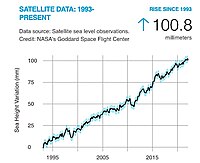
Photo from wikipedia
Abstract In the northern Bay of Bengal, mechanisms of seasonal sea-level variation have not previously been examined, and the understanding of longer-term inter-annual sea-level variation is also not concrete. These… Click to show full abstract
Abstract In the northern Bay of Bengal, mechanisms of seasonal sea-level variation have not previously been examined, and the understanding of longer-term inter-annual sea-level variation is also not concrete. These parameters are addressed in this study utilizing available tide gauge and satellite altimetry data. The contribution of steric sea level to seasonal and longer-term inter-annual sea-level variations is quantified, and statistical analysis is performed to determine the correlations of various atmospheric and oceanic factors with sea level. This study suggests that the trend of sea-level rise in this bay (4 ± 1.33 mm/year) is higher than the global average (3.32 ± 0.46 mm/year) for the studied period 1993 to 2018. The rate of sea-level rise is higher along the coast than in the offshore area and the highest in the central part of the coast. Sea level shows a strong seasonal variation: sea level is the lowest in the winter but the highest in autumn. The contribution from the thermosteric sea level is higher to the observed sea level from winter to early summer, whereas contributions from the halosteric sea level and wind stress curl are higher during autumn. Long-term variations in sea level show strong positive correlations with thermosteric sea level, indicating that temperature is a major local controlling factor for sea-level change. In addition to local factors, long-term sea level also varies by remote forcing (equatorial zonal wind stress), which explains approximately 36 % of the sea-level variation in this bay. Sea level is low during the combined events of positive Indian Ocean dipole (IOD) and El Nino, whereas the sea level is high during the combined events of negative IOD and La Nina. This study provides an improved understanding of seasonal and longer-term inter-annual variations of sea level and the necessary groundworks for a dedicated model study to further quantify all the components of the sea-level budget in the study areas.
Journal Title: Dynamics of Atmospheres and Oceans
Year Published: 2021
Link to full text (if available)
Share on Social Media: Sign Up to like & get
recommendations!